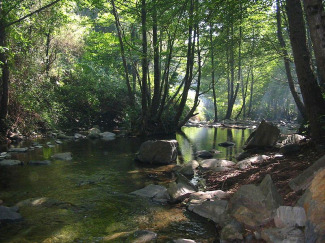Nitrogen deposition in rural areas of Catalonia, near the threshold for adverse effects on forests

Nitrogen is a fundamental component of living organisms and is a limiting factor for primary production in the biosphere. Humans have altered the global N cycle by emitting nitrogenous compounds during fossil-fuel combustion and by the industrial production of fertilizers and its subsequent application to increase food production. This anthropogenic N is added to the environment, increasing the turnover rates of the entire Earth N cycles (Vitousek et al., 1997; Galloway et al., 2008). The chemical transformations of N through its transport pathway in the environment often leads to a cascade of effects, resulting in tropospheric ozone formation, the production of acidifying compounds, generation of greenhouse gases, and ecosystem N enrichment (Galloway and Cowling, 2002; Gruber and Galloway, 2008), which induce adverse effects on the structure and function of ecosystems and also have an impact on human health (Wolfe and Patz, 2002). Although most temperate forest ecosystems remain N limited, chronic atmospheric deposition of this element may exceed ecosystem retention inducing nitrogen saturation of watersheds (Aber, 1992).
Nitrogen emissions have grown in Spain during the last 15 years. As precipitation scavenges gases and aerosols from the atmosphere, an effect on rainwater concentrations can be expected. However time-series studies on wet N concentrations in the Iberian Peninsula are very scarce. This paper aims to fill this gap by analysing weekly rainfall N concentrations at a set of rural sites in Catalonia (NE Spain) from 1995/96 to 2007 and a forest site monitored from 1983 to 2007. The sites encompass a range of rural environments and climate conditions, from the inland pre-Pyrenees (Sort) to the Mediterranean coast (Begur), and from north (Sort and Begur) to central (Palautordera and La Castanya) and south Catalonia (La Senia).
We found a 1-year cycle for concentrations of NH4+, and NO3- whereby higher values were reached at the end of spring-early summer, except at the easternmost coastal site of Begur. Weekly NH4+ concentrations decreased with time at all sites, except at La Senia, while NO3- concentrations increased at all sites during the same period. Rainfall SO42- concentrations decreased with time at all sites. The opposite trends in NO3- and SO42- concentrations determined a shift in the relative acid contribution of those anions during the 12-13 year period.
To interpret the increasing trend, mean annual NO3- concentrations were regressed against NO2 Spanish emissions and to some indicators of local anthropogenic activity. The increase at Sort and Palautordera showed good correlation with local anthropogenic indicators. Wet inorganic N deposition ranged between 4.2 and 6.7 kg ha-1y-1. When including estimates of dry deposition, total annual deposition rose up to 10-20 kg ha-1y-1, values that have been found to initiate adverse effects on Mediterranean-type forest ecosystems.
Fig 1.- Observed (open dots), fitted model (black line) and time trend (dashed line) for logarithmic bulk concentrations (microequivalent/liter) of NH4+, NO3-, SO42- and the ratio NO3-/SO42- at La Castanya (Montseny Mountains). Period 1983-2000. Significative decreasing trend for SO42- and increasing trend for NO3- and NO3-/SO42-.
Aber, J. D., 1992. Nitrogen cycling and nitrogen saturation in temperate forest ecosystems. Trends in Ecology and Evolution 7, 220-223.
Galloway, J.N., Cowling, E.B., 2002. Reactive nitrogen and the world: 200 years of change. Ambio 31, 64-71.
Galloway, J.N., Townsend, A.R., Erisman, J.W., Bekunda, M., Cai, Z., Freney, J.R., Martinelli, L.A., Seitzinger, S.P., Sutton, M.A., 2008. Transformation of the nitrogen cycle: recent trends, questions, and potential solutions. Science 320,889-892.
Gruber, N., Galloway, J.N., 2008. An Earth-system perspective of the global nitrogen cycle. Nature 451, 293-296.
Vitousek, P.M., Aber, J.D., Howarth, R.W., Likens, G.E., Matson, P.A., Schindler, D.W., Schlesinger, W.H., Tilman, D.G., 1997. Human alteration of the global nitrogen cycle: sources and consequences. Ecological Applications 7, 737-750.
Wolfe, AH, Patz, JA. 2002. Reactive nitrogen and human health: acute and long-term implications. Ambio 31, 120–125.
References
"Analysis of Decadal Time Series in Wet N Concentrations at Five Rural Sites in NE Spain" Avila, Anna; Molowny-Horas, Roberto; Gimeno, Benjamin S.; Peñuelas, Josep. WATER AIR AND SOIL POLLUTION, 207 (1-4): 123-138 MAR 2010.


